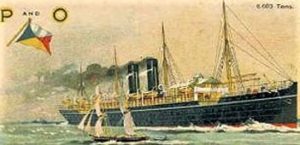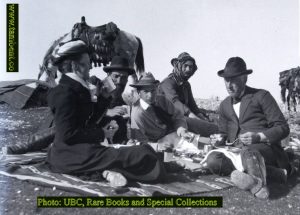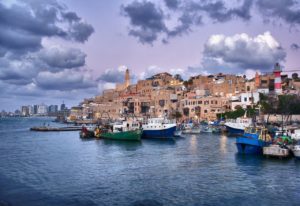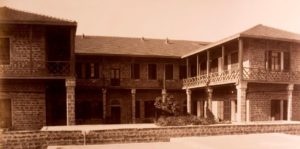
The Homeward Mail from India, China and the East for Saturday 19 December 1908 lists Mrs Theodore Bent among the passengers of the “S.S. Britannia, from London, Dec. 24, 1908 and Marseilles Jan 1., 1909; for Gibraltar, Marseilles, Port Said, Aden, and Bombay….” The P.&O. Britannia (6525 tons) was in her last year, having been launched in 1887. Disembarking at Port Said, Mabel is on her way to Palestine again; the Holy Land being almost exclusively her focus after the death of her husband, the explorer Theodore Bent, in 1897.

On a visit to Jaffa during this trip (still beautiful and peaceful then, nestled in the ‘plain of Sharon’), Mabel has a tour of the English Hospital there – in Ajami Street (now Yefet Street), opposite the Tabeetha School. She was visiting shortly after the death of the co-manager, Constance Newton, daughter of Charles E. Newton, the wealthy Derbyshire banker and landowner. Founded in the 1870s, the “Jaffa Mission Hospital was owned and operated by Mildmay Missions, an organisation which worked in conjunction with the Church Missionary Society. Constance [Newton] together with another missionary, Miss Mangan were responsible for running the facility with the help of a Syrian physician Dr Keith Ghoreyeb. After Miss Mangan’s death in 1885, the hospital was rebuilt into a functional medical facility. In 1892, Mildmay Missions bequeathed the Jaffa Mission Hospital to Constance Newton and Edith Eleanor Newton for full ownership and operation. After Constance became ill, the hospital was run by Edith and Dr. Ghoreyeb. Following her death on 19 August 1908, Constance left behind an endowment of £10,000 for the running of the hospital.” (Wikipedia) The hospital was left to the care of the Church Missionary Society and in 1944 had 160 beds and served nearly 3000 patients. A doorway survives.

One of the nursing sisters at the hospital, Sister Marie, has left an account of Mabel’s visit; it is a rare article, emphasising the celebrity status of this irresistible force. From this lengthy article in The British Journal of Nursing (Vol. 42, March 13, 1909, pp. 213-215), the paragraphs relating to Mabel are included here, under their heading “Our Foreign Letter: Under the Syrian Sun”, finding the impressionable Sister Marie carried away by the magic of the Levant and an ‘ardent lover of the East’; she loads her pen with purple ink:

“Picture to yourself an interminable garden of orange, pomegranate, and palm trees, with the plain of Sharon and the blue hills of Judea in the distance, this on one side, and on the other the sea, shining and sparkling as if the crest of each wave were studded with a thousand diamonds! … At nine the doctors come, and everything must be straight and tidy as in English hospitals back home… The doctors were late, and some of the children were getting impatient, when, instead of doctors, several travellers appeared in the corridor, one of whom was a lady, and, if she will pardon me the proclamation, may I add a very charming one? It was Mrs. Theodore Bent, who, as everyone knows, is an ardent lover of the East. After excusing herself for calling so early, she was taken round the wards, where she chatted gaily with the patients in their own language. This delighted them very much, and one woman declared she must be an Arab lady to speak so well. Before the visitors left the ward I noticed a small boy getting out of his bed, and making his way to Mrs. Bent. I looked at him and said…’Go back to your bed, Nuchly’. He paid no heed, but walked up to Mrs. Bent and said in broken English, ‘I see you one very nice lade, you come with me and I show you one very nice box in ze corridor, you will put money in, not so?’ and the Sister will buy for us one very nice muzeeka.”’ I felt so embarrassed, and wished my poor little at Jericho, especially when he added: ‘Why you looking cross, Sister? You teach me how to say it, in English, French, and Arabic. “Would you like to put somezin in the box?” You say I must sat that to all ze travelling ladies and gentlemen.’ I was much relieved when Mrs. Bent very kindly added her donation to the box, and we could pass on to another ward without the persistent little Nuchly. Through the kindness of many friends, we have our music box now, it is such a nice one, and plays ten tunes; it is a great pleasure to the patients, and had helped many of them to forget their aches and pains for a time. The women love it, and sometimes the children dance to it.”
Where are these dancing children of the Levant?
(Mabel Bent’s Travel Chronicles 1883-1898 are available from Archaeopress, Oxford in three volumes)
 Leave a comment or contact us about this article
Leave a comment or contact us about this article